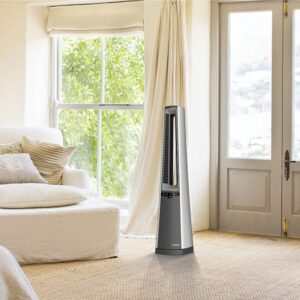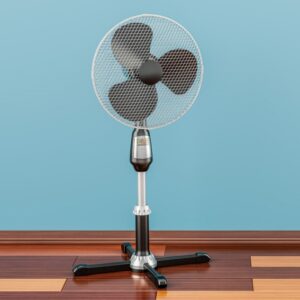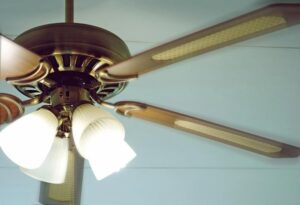
How Stand Fan Works
Are you curious how a stand fan works? This post will look at the basics of how these fans work and some standard features you can find on them. By the end, you’ll understand what to look for when purchasing your stand fan.
A stand fan consists of varying parts of the spectrum. Fans deliver air and gas at shallow temperatures, blowers are extremely powerful at medium pressure, and compressors are at high pressure. Electric fans contain motor moving blades mounted on a rotation wheel to rotate them. Other commonly used energy sources in fans are combustion engines and steam turbines. Ventilated ventilation systems circulate heat to cool rooms and reduce humidity.
What is a Stand Fan?
A stand fan is a type of electric fan that sits on the floor and is taller than a standard table fan. Most stand fans have three blades and a metal or plastic housing. The blades are connected to a central shaft powered by an electric motor. The motor rotates the shaft, which turns the blades and generates airflow. Stand fans typically have two or three-speed settings, which can be adjusted using a switch or knob on the fan’s base. Some models also have a tilting mechanism, which allows the user to circulate air upwards or downwards. Stand fans are an affordable and effective way to cool a room, and they are often used in offices, classrooms, and homes.
Types Of Fans
There are two common stand fans; tower fans and pedestal fans.
Tower Fans

Tower fans offer several advantages over pedestal fans, although they are not as powerful. One advantage is that they fit in small spaces. Another is that they often have more features, including air purification, a thermostat and a filter. They are also a little safer because the mechanism is less exposed. Moreover, tower fans look nicer and are easier to clean than pedestal fans. However, one disadvantage is that you have less control over the airflow direction. In addition, some of the “high-velocity” models can be a little noisier.
Pedestal Fans

Standing pedestal electric fan in room on the wooden floor, 3D rendering
Pedestal fans offer a variety of advantages over tower fans:
- They provide more control over the airflow, allowing you to direct the breeze exactly where you want it.
- They offer a larger airflow area, making them ideal for larger rooms and office spaces.
- They are more powerful, providing a refreshing blast of air on hot summer days.
- They can be adjusted to different heights to customize the fan to your needs.
- They are less likely to topple over than tower fans, making them safer to use.
However, pedestal fans do have some disadvantages. They can be harder to clean than tower fans because of their larger size and adjustable height. Additionally, they often do not fit with your decor as nicely as tower fans because of their bulky design. But a pedestal fan is perfect for those who need a powerful and versatile fan.
How A Stand Fan Work
Single-speed pedestal fans primarily use a single-phase AC induction motor. The fan blade is attached to a spindle that extends into the engine. Inside the motor, there are two parts. The spindle, which ends in a free-spinning piece of magnetized iron, is known as the rotor. It splits through a CV joint so that a secondary spindle extends down from the motor to rest against the worm gear in the base. Sitting on either side are the two halves of what is known as the stator. Electricity is passed through both sides of the stator, causing it to create a magnetic field. The rotor is drawn towards the stator, causing it to spin. This spinning motion is transferred to the fan’s blades, creating a cooling breeze. Single-speed pedestal fans are an efficient and affordable way to cool any room in your home.
Multi-speed pedestal fans are a little more complicated, using a voltage regulator coupled to a single-phase AC synchronous motor. The fan head is thicker due to its complexity, and the CV joint connecting the fan head spindle to the worm gear spindle is located outside the motor shaft but still within the fan’s plastic housing. In this example, the rotor is a copper cylindrical cage called a squirrel cage that rests immediately within the stator, which is also of the squirrel cage type.
The voltage regulator in an electric fan is responsible for controlling the amount of electricity that reaches the stator and rotor. More power results in a faster speed, while less power slows the fan down. In addition, the voltage regulator ensures that slightly less energy is sent to the rotor utilizing a smaller gauge wire. This difference in electrical potential between the rotor and stator generates a magnetic field, causing the rotor to spin and power the fan. By regulating the flow of electricity, the voltage regulator plays an essential role in ensuring that electric fans operate as efficiently as possible.
How About Ceiling Fans?
Now that you have a basic idea of how your stand fans work let us also get into how ceiling fans work.
Essentially mechanical fans have pretty similar mechanisms.

A motor in the ceiling fan turns electrical energy into mechanical energy. First, the ceiling fan’s capacitor torques the electric motor, forcing it to start and operate. As the electrical current enters the engine, it passes via coils of wire wrapped around a metal base. When this current flows through the wire, it generates a magnetic field that applies force in a clockwise direction. The electric energy is therefore turned into mechanical energy, which causes the motor coils to spin. With the spinning of the coils, the motor’s blades also begin to gain motion.
The mechanism behind the ceiling fan is quite simple. Air naturally stratifies – the lighter, warm air rises while the cool, heavy air sinks. The rotation mechanism of the ceiling fan is built in a way to attract the warm air upwards. As the hot air rises, the blades of the fan slice this air and push it down. This continuous process causes the air in the room to circulate in the entire room. Thus, a ceiling fan only moves the air around. Contrary to the common belief, fans do not know precisely cool down a room. Instead, they speed up the process of evaporation of sweat on our body, which naturally makes us feel a lower temperature.
Conclusion
When it comes to standing fans, there are a few different types that you can choose from. The most common type is the oscillating fan, which moves back and forth to create a cooling breeze. Another option is the tower fan, which stands upright and typically has more features than an oscillating fan. Finally, there’s the window fan, which fits in between your window panes and pulls cool air in from outside while expelling hot air out of your home. All stand fans have three main components: the blades, the motor, and the base. The blades catch the wind and use it to spin the engine. The motor then powers the blades to create airflow. The base keeps everything stable and prevents accidental tipping. Most stand fans have at least two-speed settings and adjustable tilt angles. This allows you to customize how much air you want blowing on you and where you want it directed.
Additionally, some models come with built-in timers so that you can set them to turn off automatically after a certain amount of time. When shopping for a stand fan, be sure to consider size, noise level, power usage, and added features like remote controls or automatic shut-off timers. By understanding how these fans work, you’ll be able to select one that meets your specific needs.-At their most basic level, and all stand fans operate using simple physics principles-they rely on spinning blades to move air around. But by understanding what features are available on different models and what kind of climate you’re trying to cool down, you can find a fan that works best for your needs.
Last Updated on
- How to clean standing fan easily - September 24, 2022
- How Long Does a Fan Last? – Electric fan Maintenance Guide - September 23, 2022
- Can electric fans be left on 24 hours a day? - September 23, 2022
